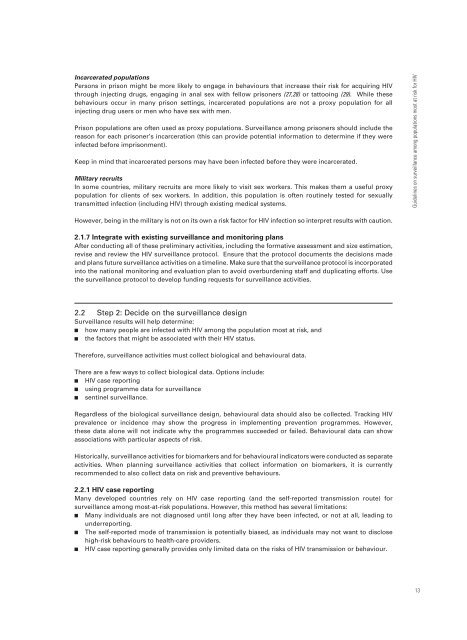Guidelines on surveillance among populations most at risk for HIV
Guidelines on surveillance among populations most at risk for HIV
Guidelines on surveillance among populations most at risk for HIV
- No tags were found...
Create successful ePaper yourself
Turn your PDF publications into a flip-book with our unique Google optimized e-Paper software.
Incarcer<strong>at</strong>ed popul<strong>at</strong>i<strong>on</strong>sPers<strong>on</strong>s in pris<strong>on</strong> might be more likely to engage in behaviours th<strong>at</strong> increase their <strong>risk</strong> <strong>for</strong> acquiring <strong>HIV</strong>through injecting drugs, engaging in anal sex with fellow pris<strong>on</strong>ers (27,28) or t<strong>at</strong>tooing (29). While thesebehaviours occur in many pris<strong>on</strong> settings, incarcer<strong>at</strong>ed popul<strong>at</strong>i<strong>on</strong>s are not a proxy popul<strong>at</strong>i<strong>on</strong> <strong>for</strong> allinjecting drug users or men who have sex with men.Pris<strong>on</strong> popul<strong>at</strong>i<strong>on</strong>s are often used as proxy popul<strong>at</strong>i<strong>on</strong>s. Surveillance am<strong>on</strong>g pris<strong>on</strong>ers should include thereas<strong>on</strong> <strong>for</strong> each pris<strong>on</strong>er’s incarcer<strong>at</strong>i<strong>on</strong> (this can provide potential in<strong>for</strong>m<strong>at</strong>i<strong>on</strong> to determine if they wereinfected be<strong>for</strong>e impris<strong>on</strong>ment).Keep in mind th<strong>at</strong> incarcer<strong>at</strong>ed pers<strong>on</strong>s may have been infected be<strong>for</strong>e they were incarcer<strong>at</strong>ed.Military recruitsIn some countries, military recruits are more likely to visit sex workers. This makes them a useful proxypopul<strong>at</strong>i<strong>on</strong> <strong>for</strong> clients of sex workers. In additi<strong>on</strong>, this popul<strong>at</strong>i<strong>on</strong> is often routinely tested <strong>for</strong> sexuallytransmitted infecti<strong>on</strong> (including <strong>HIV</strong>) through existing medical systems.<str<strong>on</strong>g>Guidelines</str<strong>on</strong>g> <strong>on</strong> <strong>surveillance</strong> am<strong>on</strong>g popul<strong>at</strong>i<strong>on</strong>s <strong>most</strong> <strong>at</strong> <strong>risk</strong> <strong>for</strong> <strong>HIV</strong>However, being in the military is not <strong>on</strong> its own a <strong>risk</strong> factor <strong>for</strong> <strong>HIV</strong> infecti<strong>on</strong> so interpret results with cauti<strong>on</strong>.2.1.7 Integr<strong>at</strong>e with existing <strong>surveillance</strong> and m<strong>on</strong>itoring plansAfter c<strong>on</strong>ducting all of these preliminary activities, including the <strong>for</strong>m<strong>at</strong>ive assessment and size estim<strong>at</strong>i<strong>on</strong>,revise and review the <strong>HIV</strong> <strong>surveillance</strong> protocol. Ensure th<strong>at</strong> the protocol documents the decisi<strong>on</strong>s madeand plans future <strong>surveillance</strong> activities <strong>on</strong> a timeline. Make sure th<strong>at</strong> the <strong>surveillance</strong> protocol is incorpor<strong>at</strong>edinto the n<strong>at</strong>i<strong>on</strong>al m<strong>on</strong>itoring and evalu<strong>at</strong>i<strong>on</strong> plan to avoid overburdening staff and duplic<strong>at</strong>ing ef<strong>for</strong>ts. Usethe <strong>surveillance</strong> protocol to develop funding requests <strong>for</strong> <strong>surveillance</strong> activities.2.2 Step 2: Decide <strong>on</strong> the <strong>surveillance</strong> designSurveillance results will help determine: how many people are infected with <strong>HIV</strong> am<strong>on</strong>g the popul<strong>at</strong>i<strong>on</strong> <strong>most</strong> <strong>at</strong> <strong>risk</strong>, and the factors th<strong>at</strong> might be associ<strong>at</strong>ed with their <strong>HIV</strong> st<strong>at</strong>us.There<strong>for</strong>e, <strong>surveillance</strong> activities must collect biological and behavioural d<strong>at</strong>a.There are a few ways to collect biological d<strong>at</strong>a. Opti<strong>on</strong>s include: <strong>HIV</strong> case reporting using programme d<strong>at</strong>a <strong>for</strong> <strong>surveillance</strong> sentinel <strong>surveillance</strong>.Regardless of the biological <strong>surveillance</strong> design, behavioural d<strong>at</strong>a should also be collected. Tracking <strong>HIV</strong>prevalence or incidence may show the progress in implementing preventi<strong>on</strong> programmes. However,these d<strong>at</strong>a al<strong>on</strong>e will not indic<strong>at</strong>e why the programmes succeeded or failed. Behavioural d<strong>at</strong>a can showassoci<strong>at</strong>i<strong>on</strong>s with particular aspects of <strong>risk</strong>.Historically, <strong>surveillance</strong> activities <strong>for</strong> biomarkers and <strong>for</strong> behavioural indic<strong>at</strong>ors were c<strong>on</strong>ducted as separ<strong>at</strong>eactivities. When planning <strong>surveillance</strong> activities th<strong>at</strong> collect in<strong>for</strong>m<strong>at</strong>i<strong>on</strong> <strong>on</strong> biomarkers, it is currentlyrecommended to also collect d<strong>at</strong>a <strong>on</strong> <strong>risk</strong> and preventive behaviours.2.2.1 <strong>HIV</strong> case reportingMany developed countries rely <strong>on</strong> <strong>HIV</strong> case reporting (and the self-reported transmissi<strong>on</strong> route) <strong>for</strong><strong>surveillance</strong> am<strong>on</strong>g <strong>most</strong>-<strong>at</strong>-<strong>risk</strong> popul<strong>at</strong>i<strong>on</strong>s. However, this method has several limit<strong>at</strong>i<strong>on</strong>s: Many individuals are not diagnosed until l<strong>on</strong>g after they have been infected, or not <strong>at</strong> all, leading tounderreporting. The self-reported mode of transmissi<strong>on</strong> is potentially biased, as individuals may not want to disclosehigh-<strong>risk</strong> behaviours to health-care providers. <strong>HIV</strong> case reporting generally provides <strong>on</strong>ly limited d<strong>at</strong>a <strong>on</strong> the <strong>risk</strong>s of <strong>HIV</strong> transmissi<strong>on</strong> or behaviour.13















